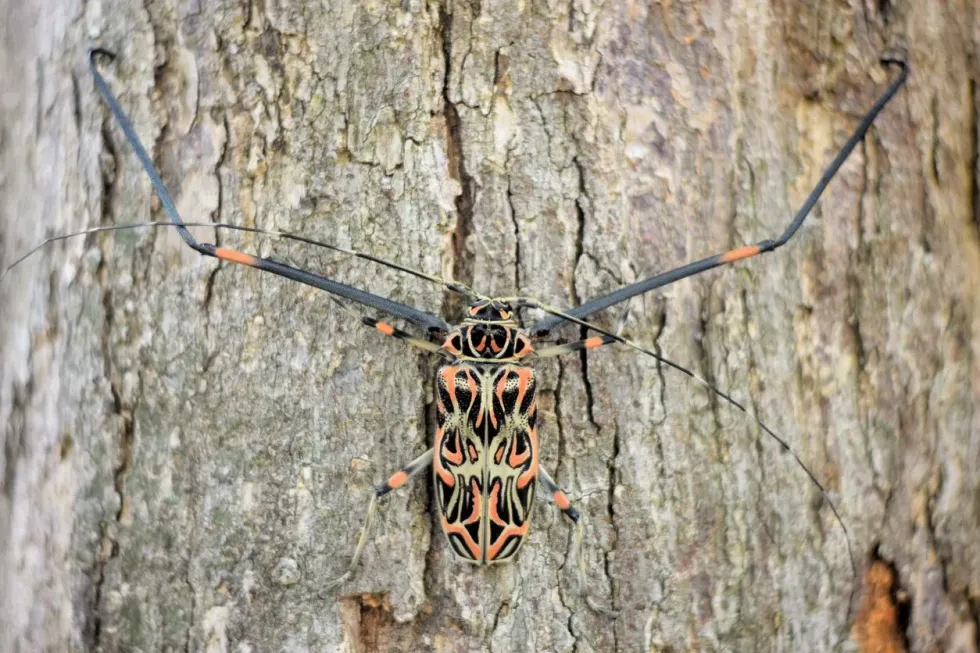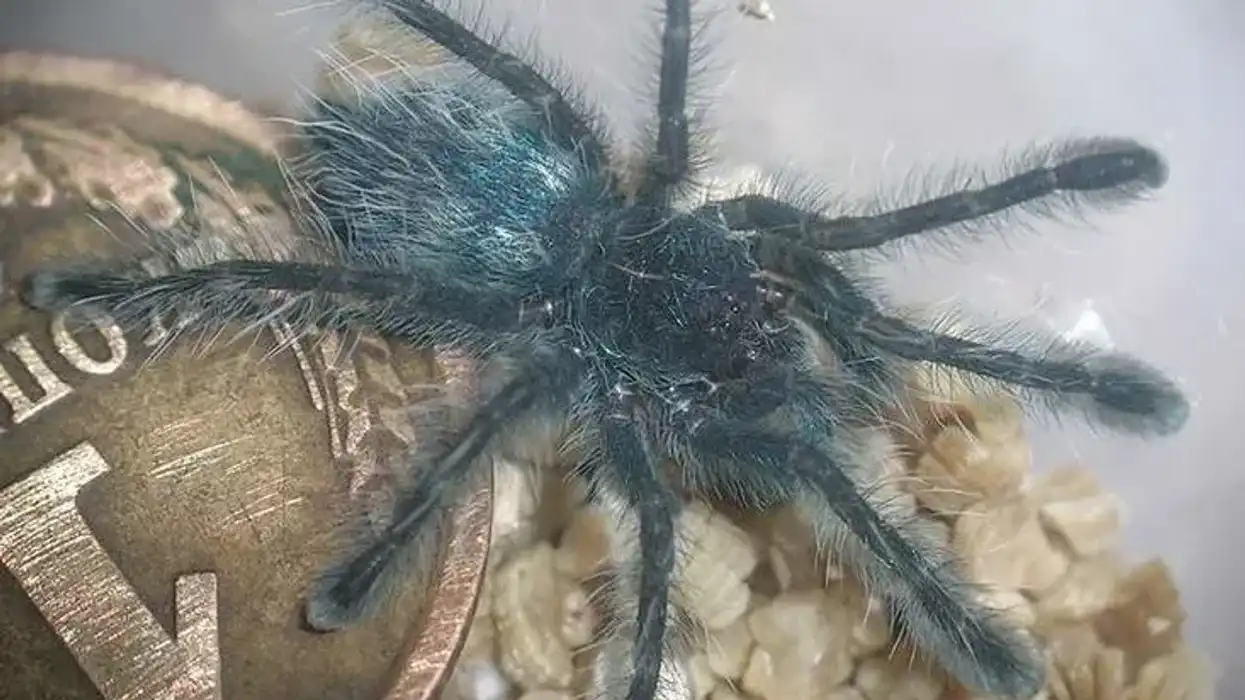The harlequin beetle (Acrocinus longimanus) is an American beetle with a beautifully variegated pattern of solid black and markings of yellow, orange, and red on its wing covers. This species is one of the longest long-horned beetles in America, and their antennae are almost longer than their body length!
As this species belongs to the Cerambycidae family, males' forelegs are considerably long, just like all other species in the family. The female beetle of this species also has long front legs; however, they are not as elongated as males.
The species' name, Acrocinus longimanus, is derived from the males' forelegs. These beetles also exhibit some traits of sexual dimorphism.
This insect is declining in terms of population and is suffering from a huge loss of habitat.
This adult insect can fly over short distances and they also have excellent mandibles that help them in escaping from their predators. An interesting aspect of these insects is their ability to camouflage with the help of the fungus present on trees.
In a nutshell, these small black insects are quite fascinating in terms of their ability to camouflage, their phoresy (they share a relationship with other animals where they help them transport), their variety of diet, and their iridescent appearance.
If you are fascinated with what you read, then you can read more about this insect below. You can also check out more articles on the paper wasp and rhinoceros beetle here too!
Harlequin Beetle Interesting Facts
What type of animal is a harlequin beetle?
Harlequin beetles are a type of longhorn beetle that is a member of the family Cerambycidae.
What class of animal does a harlequin beetle belong to?
Harlequin beetles belong to the class of Insecta.
How many harlequin beetles are there in the world?
Harlequin beetles are rare to find, and over time their population is declining due to deforestation as this creates a loss of habitat. However, their exact numbers are not known.
Where does a harlequin beetle live?
Harlequin beetles live in tropical rainforests, specifically in the trunks of tropical trees. They are distributed throughout South America, from Brazil to southern Mexico.
What is a harlequin beetle's habitat?
Harlequin beetles prefer undisturbed habitats such as damp tropical forests. They reside in the trunks of tropical trees where there are lichens and fungi. These beetles are found in almost dead trees or ones that are dying as they actively feed on the tree's sap.
Who do harlequin beetles live with?
Harlequin beetles exhibit solitary behavior; thus, generally, they don't travel in groups and are mostly found alone.
How long does a harlequin beetle live?
Harlequin beetles can live up to 10 years, out of which they spend a part of their lifespan in the larval stage.
How do they reproduce?
Male harlequin beetles have long arms that have a lot to do in attracting females. Oviposition occurs in the spring or fall season in the logs or trunks of these tropical trees, which are coated with fungus.
Before spawning, the females create a small depression in the bark to lay their eggs. They can lay around 15-20 eggs in two or three days.
Generally, they choose tropical trees which have an abundance of sap to provide nourishment to the eggs. Their life cycle comprises four stages until they become fully developed and independent.
Metamorphism includes the eggs stage, which is just after the eggs are released and ends after the hatching of eggs. The larval stage takes around eight months when the larvae develop.
This is followed by the pupa stage, and then finally, the adult beetle makes it is way out after four months in the pupa stage. Therefore, a harlequin beetle's life cycle is year-long.
What is their conservation status?
Harlequin beetles are not listed in the International Union for Conservation of Nature (IUCN) Red list.
Harlequin Beetle Fun Facts
What do harlequin beetles look like?
The harlequin beetle (Acrocinus longimanus) is a large long-horned beetle that has a detailed pattern of black and orange, yellow-green markings all over its toughened wings which are termed ‘elytra’. The males have long front legs and antennae, which help them lure females and defend against predators while guarding the female and their offspring.
Females also have long arms, but these are not as elongated as those of males.
How cute are they?
Harlequin beetles are beautiful, but some might find them unappealing due to their small size and yellow patterns.
How do they communicate?
They mainly communicate through visual channels. For instance, the males use their long front legs to lure female beetles.
How big is a harlequin beetle?
The harlequin beetle is considerably large, and they are around 3 in (7.6 cm) in length. They are around two times bigger than stag beetles.
How fast can a harlequin beetle run?
Harlequin beetles are swift. However, exact information about their speed is not yet evaluated.
How much does a harlequin beetle weigh?
The harlequin beetle is large and stocky-built. However, their exact weight is not calculated or evaluated.
What are the male and female names of the species?
There is no distinctive name for males and females. They are simply collectively known as the harlequin beetle.
What would you call a baby harlequin beetle?
A baby harlequin beetle can be termed a hatchling.
What do they eat?
The Harlequin beetle is a herbivore beetle. Their diet includes bark, the sap of trees, fungi, and wood. They are also detritivores and can feed on excrement.
Are they poisonous?
No, they are not poisonous, and they do not pose any harm or threats to humans. However, they can release some toxic substances that may irritate the spot of contact.
Would they make a good pet?
No, they would not make a good pet as they are adapted to the undisturbed habitat of tropical forests.
Did you know...
A harlequin beetle possesses the ability to sense the presence of sap when a tree falls or starts decaying and they track and fly to it in a short period.
A harlequin beetle is attracted to light gravitationally. Hence, they usually tend to be active during the day and dormant throughout the night.
The harlequin beetle tends to act as a host to some small arachnids, namely pseudoscorpions that are present underneath their wing covers. Pseudoscorpions use them to travel around safely to forage for food and to find their potential mating partners.
Interestingly, pseudoscorpions bind themselves to the abdomen of the harlequin beetle, and once they reach a new destination, these minute arachnids climb off with the help of silk strands. The beetles of the harlequin name are often found transporting such tiny arthropods.
Do harlequin bugs bite?
Yes, they might bite if startled. It is often observed that these bugs bite humans if they are disturbed. These bites may cause an itchy bump or irritation at the spot as they release a reactive chemical, but it is not poisonous. However, having them around in gardens is not ideal for this reason.
Harlequin beetles within the food chain
They are herbivores and phytophagous insects, so they feed on plant matter and decaying organic material as well, and some higher-order mammals, birds, and lizards feed on them. They are eaten by mockingbirds, sparrows, and even turtles.
Here at Kidadl, we have carefully created lots of interesting family-friendly animal facts for everyone to discover! Learn more about some other insects, from our ground beetle facts and ladybird facts pages.
You can even occupy yourself at home by coloring in one of our free printable Harlequin beetle coloring pages.










